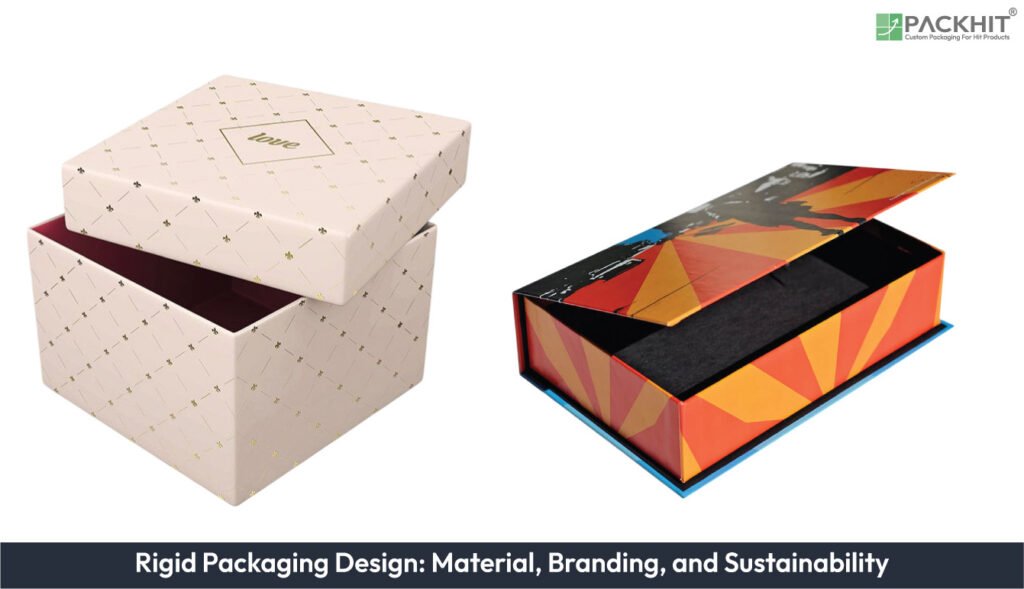Rigid packaging design is a multi-faceted approach that combines material science, branding innovation, and sustainability principles to create packaging solutions that balance durability, aesthetics, and eco-consciousness. It utilizes materials like paperboard, corrugated fiberboard, and molded pulp, each chosen for its unique properties such as structural integrity, printability, and biodegradability. Branding in rigid packaging integrates visual elements, custom structural features, and advanced print technologies, transforming packaging into an extension of the brand identity. Sustainability is addressed through the use of recycled materials, biodegradable options, and lightweighting strategies to minimize environmental impact. These interwoven aspects, like material selection, branding, and sustainability, work cohesively to meet the diverse demands of manufacturers and consumers, ensuring that rigid packaging solutions are functional, visually engaging, and environmentally responsible.
What Materials Are Commonly Used in Rigid Packaging Design?
Rigid packaging relies on materials that offer structural stability, resistance to deformation, and compatibility with various manufacturing processes. Commonly used materials in the design of rigid packaging are detailed below:
Paperboard
Paperboard, a thick and durable paper-based material, is widely used in rigid packaging due to its versatility and printability. It is available in various grades, such as solid bleached sulfate (SBS) and coated unbleached kraft (CUK), each offering distinct properties. SBS paperboard, for instance, provides a smooth surface ideal for high-quality printing, while CUK offers superior strength and moisture resistance, making it suitable for packaging heavier or moisture-sensitive products.
Corrugated Fiberboard
Corrugated fiberboard, composed of a fluted corrugated sheet sandwiched between two flat linerboards, is valued for its strength-to-weight ratio. It is commonly used in shipping and storage applications where impact resistance is critical. The material’s structural integrity can be adjusted by varying the flute size and the thickness of the linerboards, allowing for customization based on product requirements.
Molded Pulp
Molded pulp, derived from recycled paper or cardboard, is an eco-friendly material used in rigid packaging. It is often employed for protective inserts, trays, and containers due to its cushioning properties and biodegradability. The material can be molded into complex shapes, providing tailored protection for fragile items such as electronics and glassware.
How Does Branding Influence Rigid Packaging Design?
Branding plays a pivotal role in rigid packaging design, transforming functional packaging into a medium for consumer engagement and brand identity reinforcement. Key branding considerations include:
Visual Design and Aesthetics
The visual design of rigid packaging encompasses elements such as color schemes, typography, and graphic imagery. These elements are strategically chosen to align with the brand’s identity and appeal to the target audience. For example, luxury brands often use minimalist designs with metallic finishes to convey sophistication, while eco-conscious brands may opt for earthy tones and natural textures to emphasize sustainability.
Custom Structural Features
Rigid packaging can be customized with unique structural features, such as magnetic closures, die-cut windows, or embossed surfaces, to enhance the unboxing experience. These features not only add a tactile dimension to the packaging but also create a memorable interaction that reinforces brand loyalty.
Print Technologies
Advanced printing technologies, such as offset printing, digital printing, and hot stamping, enable high-resolution graphics and intricate designs on rigid packaging. These technologies allow for the incorporation of brand logos, product information, and promotional messages, ensuring consistency across all packaging elements.
What Are the Sustainability Considerations in Rigid Packaging Design?
Sustainability in rigid packaging design addresses the environmental impact of packaging materials and processes. Manufacturers are increasingly adopting practices that minimize waste, reduce carbon footprints, and promote recyclability. Key considerations include:
Use of Recycled Materials
Incorporating recycled content into rigid packaging materials reduces the demand for virgin resources and lowers the environmental impact. For instance, recycled paperboard and molded pulp are commonly used to create sustainable packaging solutions without compromising structural integrity.
Biodegradable and Compostable Options
Biodegradable materials, such as molded pulp and certain types of paperboard, decompose naturally, reducing long-term waste accumulation. Compostable coatings and adhesives further enhance the eco-friendliness of rigid packaging by ensuring that all components break down in composting environments.
Lightweighting and Material Optimization
Lightweighting involves reducing the material thickness or weight without compromising functionality. This approach not only decreases material usage but also reduces transportation emissions by lowering the overall weight of packaged goods. Material optimization techniques, such as structural redesigns, further enhance efficiency.

